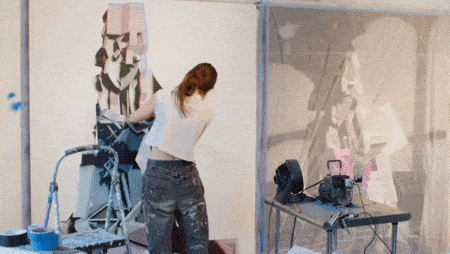Born in Rutland, Vermont, Todd Elkin is a visual artist, writer, researcher, activist and arts educator currently living in Oakland, California. He has an extensive visual arts background including work as a professional printmaker and freelance illustrator. He is currently the Fine Arts Department Chair and an art teacher at Washington High School in Fremont, California where he focuses on co-designing (with students and other teachers) and facilitating student-driven, art-centered trans-disciplinary curriculum, fostering cultures of critical thinking and reflection.
As an educator, Todd is motivated by issues of social justice and equity in matters of race, class and gender and he’s committed to creating spaces for students to engage in relevant lines of inquiry about these and other important themes. Todd joins us on the Art21 Magazine as the September/October Educator-in-Residence.
Why do you believe the thinking and practices of contemporary artists are important to incorporate in the classroom? What do students get out of it that they might not otherwise?
I really believe contemporary artists are ideal role models for youth. They model self-driven proactive dispositions, cycles of inquiry and innovative strategies. They push against all kinds of boundaries in ways that can open doors for young people who are questioning the status quo. Contemporary artists are engaged in a continual process of empowered self-assessment that embraces failure, uncertainty and chance as important elements of their practice. They show up in the studio and battle it out each day in ways that model a growth mindset for students.
Also, many contemporary artists’ work is research, and involves a process that often results in new insights, which then trigger new inquiries. Their artworks can be excellent catalysts for dialogue and the construction of meaning in and outside of classrooms.
Contemporary artists understand that the world is an inherently transdisciplinary place, which means that they must adopt transdisciplinary approaches. They are both critical thinkers and critical changemakers. Contemporary artists perform functions that other types of practitioners do not. They effect transformations, operate simultaneously on intellectual and emotional levels, and dwell in liminal, interstitial spaces. Many of the attributes and attitudes of contemporary artists stand in stark contrast to compliance-based classrooms. These qualities are so useful for students to see, and Art21 has opened such an important window onto all of these processes.
Why were you initially drawn to the Art21 Educators program?
I first heard about the Art21 Educators program from Lois Hetland who had been working with the program in its first couple of years. Lois had just come back from the Year 2 Summer Institute and she described an amazing TASK party that Oliver Herring led, with tasks like “have a tea party for the queen” and “start a revolution.” This was the first I’d heard about TASK. I was immediately intrigued and wanted to know more about Oliver’s work and the program. What I found out made me want to apply, so I did and was accepted for Year Three. It was one of the best personal and professional decisions I have ever made.
Read the rest of Todd’s interview on the Art21 Magazine, and keep an eye out for his education posts throughout the September/October issue, “Invention.”


